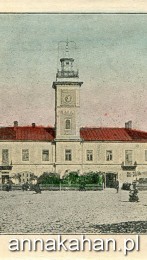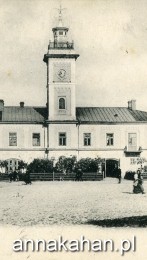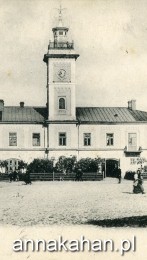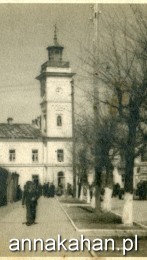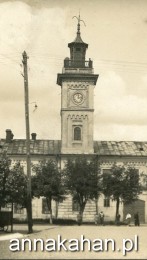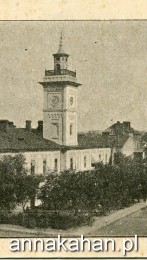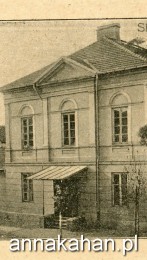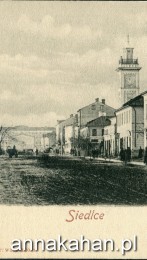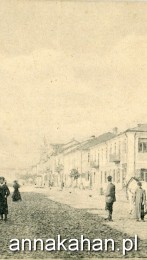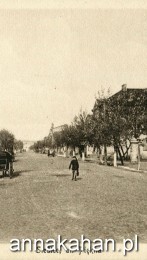[The Municipal building]
Our tour “In the Footsteps of Anna Kahan” begins from the place where the municipal building was located during her lifetime.
The building was erected between 1824 and 1829. Its façade faced Rożniecki Street, which from 1840 was named Warszawska Street. Today, the street is called Piłsudski Street. The offices of the municipal administration were located here in 1862. Following this, the building became the seat of the municipal authorities.
The architectural style of the building followed the neoclassical design of the post office façade, the palace, and the Saint Stanislaus church. It was located between Morska and Przechodnia Streets, directly in front of the District Governor’s Office. At the back of the building, a New Town Hall was built facing current Pułaski Street. To make it easier to imagine the layout of the buildings, let us say that the current statue of Pope John Paul II would be situated between these two buildings. In September 1939, both buildings were bombed by the German air force. The municipal building would be located today on the side of Józef Piłsudski Street with odd numbering.
After the outbreak of the First World War, the municipal building housed the Citizens’ Committee, which was appointed to oversee the functioning of the city and for maintaining order.
On the morning of August 12, 1915, German troops marched to Siedlce. The next day, the occupation authorities issued a decree on the introduction of a curfew, which was in force from 8 p.m. to 5 a.m.
The last meeting of the Citizens’ Committee was held on November 4, 1915. By the order of the occupation authorities, the City Board was established to take control over the urban economy. It consisted of a German mayor, a Polish mayor, and four lay judges. The board was also supported by twenty-four members of the City Council.
The Municipal Authorities and the City Board were used by German occupation authorities to inform the residents of the city about all sorts of regulations as well as financial and material penalties. In those years, Siedlce had a population of about thirty thousand.
Anna Kahan recalls this event in her diary on November 11, 1915.
“New announcements: Deliver all the wheat or cornmeal in your possession; no in or out transportation of goods or products; the Wójts (‘village officials’) are to watch that no cattle, grain or other products shall be sold or transported through their villages.
All business is at a standstill. Wherever you turn, you encounter: Verboten! (‘forbidden’). Fine and confiscation. This week the Germans took away merchandise from people who had a permit for it. The permit, they said, was issued by an officer who has nothing to say about merchandise. Many of these people have lost that way their last possessions, others lost not only their own, but their friends’ money, having bought the goods on borrowed money.
And so the family of paupers is growing. How can one live? Many are starving, and those who still have savings dread the moment when they will be all used up.”
The first information about the municipal building Anna wrote on January 27, 1915, during the Russian occupation. She described the crowd, which gathered in front of the building in order to read the Tsarist army recruitment notice for men under the age of fifty. Anna was worried that her father would be called up. Although she did not read the document, she believed her friends who had seen it. Later, it turned out that only coachmen with their own horses were needed. Volunteers would receive pay.
The next time she wrote about the building was almost a year later on January 17, 1916, which was during the German occupation. On that day, when she was passing in front of the municipal building, which was watched by a guard, and she saw a large crowd of people, who were mostly women. They were waiting for their husbands who were called up to the army as reservists. They said that the men would probably be sent home as the Germans did not want to pay for their food.
During the First World War, the Germans regulated the prices of food products. On their order, the authorities lowered the sale price of meat, which Anna Kahan described on January 22, 1916. This led to the collapse of the meat market, and financial problems for Anna’s family, as her father worked in the meat trade.
The family’s financial situation improved thanks to a donation from the United States of America. Anna mentioned this on September 18, 1916.
“(…) on the wall of the Magistrat a notice was posted with names of people to whom money had been sent from America. Our name was included for 98 marks!”
We now go to Pułaski Street, which in Anna Kahan’s time was located at the already mentioned New Town Hall. We go westbound to the left side of the street. On the left side, at the corner of Pułaski and Armii Krajowej Streets, is now a Market Hall. In Anna Kahan’s time, the Jewish Hospital was next door.




